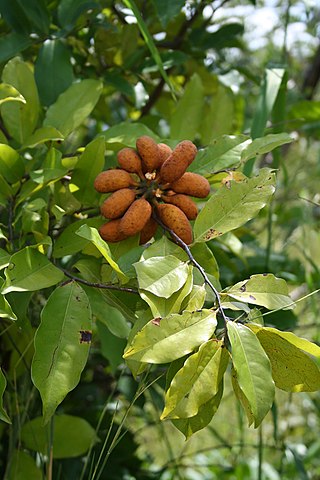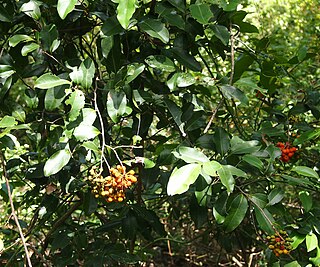
In electronics, a digital-to-analog converter is a system that converts a digital signal into an analog signal. An analog-to-digital converter (ADC) performs the reverse function.

The Annonaceae are a family of flowering plants consisting of trees, shrubs, or rarely lianas commonly known as the custard apple family or soursop family. With 108 accepted genera and about 2400 known species, it is the largest family in the Magnoliales. Several genera produce edible fruit, most notably Annona, Anonidium, Asimina, Rollinia, and Uvaria. Its type genus is Annona. The family is concentrated in the tropics, with few species found in temperate regions. About 900 species are Neotropical, 450 are Afrotropical, and the remaining are Indomalayan.

Kniphofia is a genus of perennial flowering plants in the family Asphodelaceae, first described as a genus in 1794. The species are native to Africa. Common names include tritoma, red hot poker, torch lily and poker plant.

Kniphofia uvaria is a species of flowering plant in the family Asphodelaceae, also known as tritomea, torch lily, or red hot poker, due to the shape and color of its inflorescence. The leaves are reminiscent of a lily, and the flowerhead can reach up to 1.5 m (5 ft) in height. There are many varieties of torch lily, and they bloom at different times during the growing season. The flowers are red, orange, and yellow.

The Centre for Development of Advanced Computing, Thiruvananthapuram (C-DAC[T]) is a branch of the Indian Centre for Development of Advanced Computing based in Thiruvananthapuram.
Monocyclanthus is a monotypic genus of flowering plants in the family Annonaceae containing the single species Monocyclanthus vignei. It is native to Ghana and Liberia. It is a rare plant of the understory of wet evergreen forest habitat.
Uvaria kweichowensis is a species of plant in the Annonaceae family. It is endemic to China.

Uvaria is a genus of flowering plants in the family Annonaceae. The generic name uvaria is derived from the Latin uva meaning grape, likely because the edible fruit of some species in the genus resemble grapes.

Uvaria chamae, commonly known as finger root or bush banana is a climbing large shrub or small tree native to tropical West and Central Africa where it grows in wet and dry forests and coastal scrublands. The common name refers to the fruit growing in its small bunches; the fruit is edible and widely eaten. U. chamae is a medicinal plant used throughout its range to treat fevers and has antibiotic properties. An extract of Uvaria chamae, administered orally at 300–900 mg/kg/day showed significant antimalarial activity against both early and established infections.

Uvaricin is a bis(tetrahydrofuranoid) fatty acid lactone that was first isolated in 1982 from the roots of the Annonaceae Uvaria acuminata. Uvaricin was the first known example in a class of compounds known as acetogenins. Acetogenins, which are found in plants of the family Annonaceae, seem to kill cells by inhibiting NADH dehydrogenase in the mitochondrion. A method to synthesize uvaricin was first published in 1998, and an improved stereoselective synthesis published in 2001.

Uvaria leichhardtii, commonly known as zig-zag vine, is a species of vine in the family Annonaceae. It is native to parts of Malesia, New Guinea, and the eastern Australian states of Queensland and New South Wales.
Uvaria rufa is a species of vines or shrubs commonly known as susung-kalabaw or Torres Strait scrambler, of the plant family Annonaceae. It grows naturally in Cambodia, Laos, Thailand, New Guinea, more widely in Malesia and in Cape York Peninsula Australia.

Uvaria narum is a large woody climber belonging to the family Annonaceae which occurs in the hilly regions of western peninsular India and Sri Lanka. It was described by Nathaniel Wallich in his catalogue at serial 6473 in 1829. Essential oils can be extracted from the leaves of the plant.

Direct air capture (DAC) is the use of chemical or physical processes to extract carbon dioxide directly from the ambient air. If the extracted CO2 is then sequestered in safe long-term storage, the overall process will achieve carbon dioxide removal and be a "negative emissions technology" (NET).

Uvaria dulcis is a species of woody climber in the Annonaceae family. It is found in tropical Asia, in a disjunctive distribution, eastern Indonesia, Jawa, and then Mainland Southeast Asia. The plant has an edible fruit, which in Khmer language has the colourful name triël dâhs krabéi.
Neo-uvaria is a genus of flowering plants belonging to the family Annonaceae.

Uvaria grandiflora is an Asian liana species in the family Annonaceae and tribe Uvarieae. Its native range includes: China, Indochina, Malesia and New Guinea.

Uvaria macrophylla, also known by its common name large-leaved uvaria, is a species of flowering plant in the family Annonaceae. The species was originally described by William Roxburgh in 1832. The name is a synonym of Uvaria littoralis (Blume) Blume.













